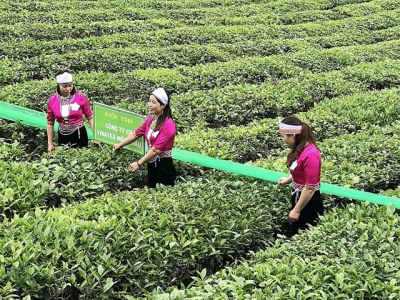Rare supply - demand imbalance of tea market

Before the impact of the Covid-19 pandemic, the global tea market has been experiencing a rare supply-demand imbalance in recent years when the supply faces a shortage and the demand is increasing sharply.
It is forecast that the supply - demand imbalance will not last long. Photo: Nguyen Thanh
According to the Department of Agricultural Product Processing and Market Development (Ministry of Agriculture and Rural Development), facing the impact of the Covid-19 pandemic, the global tea market has been experiencing a rare supply-demand imbalance in recent years.
Specifically, the tea harvesting process of many countries is interrupted by labor shortages when many countries issue social distancing policies, while the demand for tea – a beverage known for the effect of strengthening the immune system – increases sharply.
Trade restrictive policies to minimize the spread of the Covid-19 pandemic, especially in five countries China, India, Kenya, Sri Lanka and Vietnam (accounting for over 80% of the global tea market), which are applied in the middle of the peak season of tea harvesting, have caused interruptions in tea exports for about a month, affecting the supply, pushing up the tea price of tea on the global market dramatically.
Tea selling prices at auctions in May (as of May 20) in Mombasa, Kenya averaged US$4.33 / kg, up 1.4% from the previous month.
However, the parties involved in tea production and exports, as well as the International Tea Committee,believe that this trend will not last long, because most of the tea exporting countries will have an oversupply in 2020.
Regarding the tea export in Vietnam, the report of the Department of Processing and Agricultural Product Market Development stated that: from the beginning of the year to the end of May, the volume and value of tea exports were estimated at 46,000 tons and US$71 million, down 2.3% in volume and 11.3% in value over the same period in 2019.
In the first four months of the year, tea volume exported to Pakistan – Vietnam's largest market – amounted to 30.6% market share, down by 14.1% in volume and 19% in value over the same period in 2019. The average export price of tea in the four months only reached US$1,516 / ton, a year-on-year decrease of 11%.
In the domestic market, tea prices in May generally remained stable. In Thai Nguyen, the price of high-quality stem tea keeps stable at VND200,000/ kg, dried green tea buds VND100,000 /kg, dried green tea buds (preliminary processed type 1) VND130,000 / kg. In Bao Loc (Lam Dong), the tea stem price is stable at VND9,500 / kg, grain tea increased slightly by VND200 / kg to VND7,500 / kg.
Related news
 Japan to resume import of Vietnamese fresh lychees soon
Japan to resume import of Vietnamese fresh lychees soon Japanese experts will arrive in Vietnam on June 3 to directly inspect and supervise the quarantine activities for batches of Vietnamese lychees to be exported
 Vietnam wins bid to supply rice to the Philippines
Vietnam wins bid to supply rice to the Philippines Vietnam has won a tender offered by the Philippines to export 60,000 tonnes of rice to the partner country at a higher price than that of countries which won
 Fruit exports to EU urged to obey origin traceability rules
Fruit exports to EU urged to obey origin traceability rules The European Union –Vietnam Free Trade Agreement is anticipated to create a range of export opportunities for agricultural products, especially Vietnamese fruit